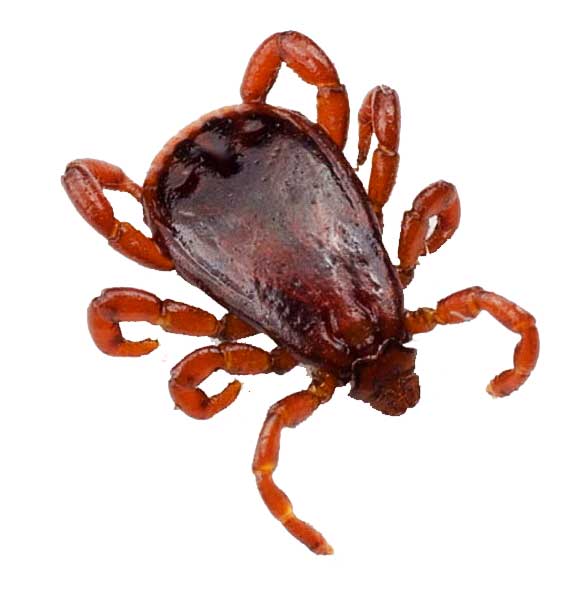(Parasitiformes Ixodida)
Description
Ticks are small, wingless arthropods. Adult ticks are about the size of an apple seed. Nymphs are about the size of a poppy seed, while larva are the size of a grain of sand. Ticks are flat and oval-shaped until they have a meal. Then they become fat and engorged.
Nymphs and adults have eight legs, but tick larvae have just six. Ticks can be a variety of colors depending on the species. There are deer ticks, dog ticks, black-legged ticks, Lone Star ticks, and more. However, there are two main classifications: hard-shell and soft-shell ticks. Common colors include grayish-white, brown, black, reddish-brown, and yellowish in color.

Additional Information
Habits & Behavior
Ticks live outdoors. They hide in grass, trees, shrubs, and underbrush. Ticks are at their peak population in the spring and summer months, from April through September.
Ticks can feed on mammals, birds, reptiles, and amphibians. Most ticks prefer to have a different host animal at each stage of their life. They are attracted to carbon dioxide and sweat.
Ticks can’t jump up or drop down on hosts, so hard-shell ticks in particular have to find their host by ‟questing.” This involves crawling up onto long weeds and grass. A tick may also perch itself on leaf edges or other vegetation. There, it waits for a host to pass by, with its clawed front legs ready to grab hold of you.
As the questing tick finds a host, it grabs on with its extended front legs, then quickly crawls to feed on exposed skin. Tick larvae will quest at ground level, while tick nymphs can climb up a little ways to find bigger hosts. Adult ticks can climb the highest, which is why many tick bites occur around the head and neck. Ticks also like the armpit and groin areas. Feeding sessions can last from several hours to several days.
Food
Ticks are picky when it comes to their food. They will only eat one thing: blood. A tick must find blood to eat three times during its life — first as a larva, then as a nymph, and finally as an adult. Ticks consume only one blood meal at each of these three stages.
Ticks eat slowly and will feed on one host for 3-5 days. They do not need to eat a lot. It is not uncommon for a tick to not have a host for 1-2 years.
Reproduction
Most ticks go through four life stages: egg, six-legged larva, eight-legged nymph, and adult. Female ticks typically lay their eggs in the spring once they have reached 2 years old. A tick needs to completely detach from its host before reproduction, so they cannot physically lay eggs directly on a host. They will lay eggs in coat linings, carpeting, furniture, and outdoor leaf brush. One tick can lay thousands of eggs.
After hatching from the eggs, ticks must eat blood at every stage to survive. Ticks that require this many hosts can take up to three years to complete their full life cycle. Most will die because they don’t find a host for their next feeding.
Ticks become nymphs between the fall and spring. They become inactive when temperatures drop below 45 degrees Fahrenheit. They may nest on a host without feeding or sit dormant in leaf litter.
Once the nymph is saturated with blood, it will fall off of its host and come to its adult life stage during the fall. This is when the tick will look for its third and final host for feeding. Ticks will nest or begin mating. Males typically die after mating with one or two females. Females will die after laying thousands of eggs during the spring.
Signs
Ticks can remain attached to your skin for up to two weeks, so if you have a tick on your body, you will likely know. Ticks get bigger and easier to spot as time goes on.
Ticks will leave a red bump that looks like a mosquito bite. Ticks do not usually bite in clusters or lines, so if you have multiple red marks on your body, it is probably a different pest biting you.
If you have Lyme disease, a bullseye rash will appear on your skin within 3 to 30 days after you’ve been bitten. The rash may get larger over several days, reaching up to 12 inches wide.
Dangers
Ticks can spread a plethora of diseases, including the following:
- Lyme disease
- Tularemia
- Rocky Mountain spotted fever
- Colorado tick fever
- Anaplasmosis
- Babesiosis
- Ehrlichiosis
- Southern tick-associated rash illness (STARI)
- Tick paralysis
- Spotted fever
- Relapsing fever
- Heartland virus
In 1984, Lyme disease was found to be present in Texas. It is now found in 1-2% of ticks in Texas, so it’s the disease you need to be most concerned about. Symptoms include fever, headache, fatigue, and skin rash.
Not all tick bites will result in disease. You may feel just fine afterward. If you develop a rash, fever, achiness, or fatigue, seek medical attention. Some diseases can be serious and even life-threatening.
Ticks can also cause allergies and itchiness to humans and pets. Be sure to use tick repellent on your pets to keep them itch-free. Frontline is a good choice.
Contact Us Today
Ticks are blood-sucking creatures that can cause a lot of trouble to humans and animals. They can spread diseases and annoy pets.
Are ticks getting under your skin? If so, get professional pest control from the team at Stride Pest Control. Request a quote today. Call (512) 777-1339 (Austin) or (210) 547-8410 (San Antonio) or fill out the online form to schedule a free consultation.
Number of days a tick can suck your blood
10
Tick bites that can result in Lyme Disease
5%
Annual cases of tick born diseases in U.S.
60,000
Ticks in the north & midwest that are infected
50%
Get a FREE Consultation


